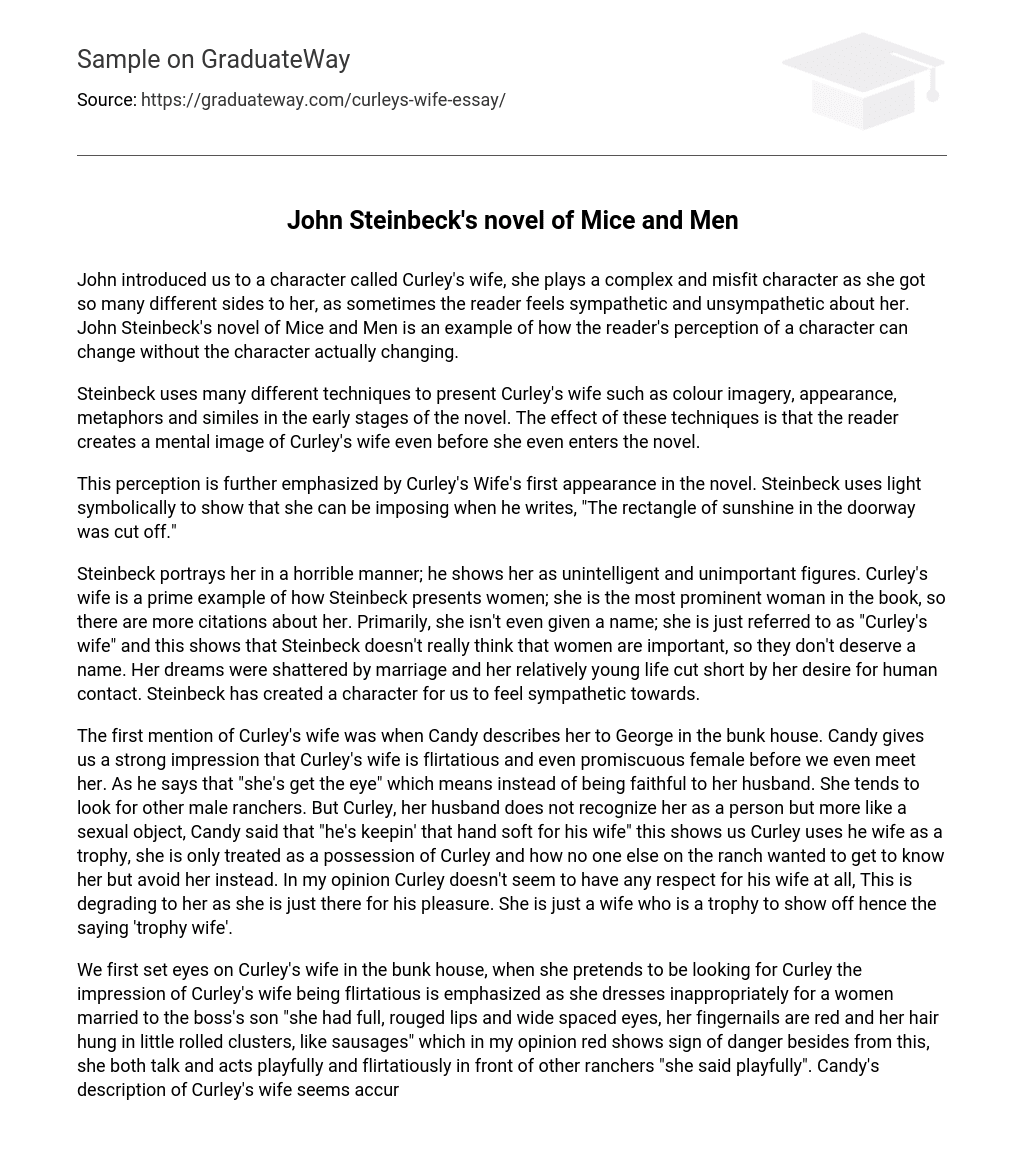The portrayal of Curley’s wife in John Steinbeck’s Of Mice and Men is multifaceted, eliciting both sympathy and unsympathetic reactions from readers. It highlights the fluidity of perception towards a character that remains constant.
Steinbeck employs various techniques, including colour imagery, appearance, metaphors, and similes, to introduce Curley’s wife in the early chapters of the novel. These techniques enable the reader to form a mental image of her character even before her actual appearance in the story.
This perception is further emphasized by the initial appearance of Curley’s Wife in the novel, as Steinbeck employs symbolic use of light to convey her imposing nature: “The rectangle of sunshine in the doorway was cut off.”
Steinbeck depicts Curley’s wife in a derogatory manner, portraying her as an unintelligent and insignificant character. She serves as a representative example of how women are presented in the book, as she is the most prominent female figure. Consequently, there are numerous references to her throughout the narrative. Notably, she is not assigned a name but is merely referred to as “Curley’s wife,” highlighting Steinbeck’s perception that women are inconsequential and unworthy of recognition. Additionally, her aspirations were shattered by marriage, and her relatively young life was tragically cut short due to her craving for companionship. Ultimately, Steinbeck has crafted this character to evoke sympathy within us.
The first mention of Curley’s wife occurs when Candy describes her to George in the bunk house. According to Candy, Curley’s wife is a flirtatious and promiscuous individual. He mentions that she has a wandering eye, indicating that she is not faithful to her husband and tends to pursue other male ranchers. However, Curley views her more as a sexual object rather than a person. Candy remarks that Curley keeps his hand soft for his wife, implying that Curley treats her as a possession or trophy. It is evident that nobody else on the ranch attempts to form a connection with her; instead, they intentionally avoid her. In my opinion, Curley lacks any respect for his wife, subjecting her to the role of mere pleasure. She is regarded as a trophy wife, existing solely for display purposes.
We are introduced to Curley’s wife in the bunkhouse, where she puts on a charade of searching for her husband. The way she dresses is inappropriate for someone married to the boss’s son, with full, rouged lips and wide spaced eyes, red fingernails, and hair styled in little rolled clusters. This attire, in my view, suggests danger. Additionally, she speaks and behaves in a playful and flirtatious manner around the other ranchers. Candy’s description of her seems accurate after her initial appearance. George notices this and purposely avoids engaging in conversation with her, responding with brief replies like “Well he ain’t now.” He views Curley’s wife as someone who may cause trouble due to her flirtatious nature before understanding her motives.
Dreams play a significant role in this book, including the character Curley’s wife who has aspirations of becoming a film star. While she may seem like she is causing trouble for the men on the ranch, her dreams and frustrations highlight her loneliness, similar to others. Disliking her upbringing, she saw an opportunity when a man claimed she had potential to be a movie star and promised to stay in contact. Unfortunately, being young and naive, she believed his words and never encountered him again.
Her only form of power is her sexual allure; she yearns for attention through her appearance. When someone gazes at her, she seizes the opportunity to capitalize on this attention. Although she attempts to use her charm on Lennie, she feigns trust to further garner his attention.
Steinbeck aims to confuse us regarding Curley’s Wife, with a consistent portrayal. At first, she is seen as promiscuous and flirtatious, neglecting her husband. However, as we hear more of her perspective through dialogue, our sympathy towards her increases.
The text reveals a shift in our perspective towards Curley’s Wife when she visits Crooks, an African American worker, and interrupts his conversation with Lennie and Candy. Upon entering, she inquires about Curley’s whereabouts. After receiving cold responses from the men, she opens up about her loneliness and yearning for independence. However, her tone quickly turns hostile as she verbally attacks the men and dismisses her apathy towards Curley. When Crooks asks her to leave, she responds with a lynching threat. As she exits, Steinbeck skillfully uses the metaphor of horses stamping their feet to depict the disruption and discomfort she causes. This pivotal moment in the novel evokes sympathy for Curley’s Wife, who is trapped in a loveless marriage due to her loneliness and boredom: “i get awful lonely.”





